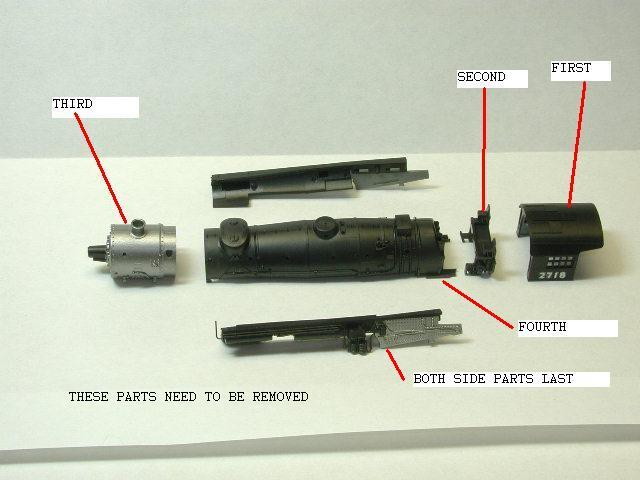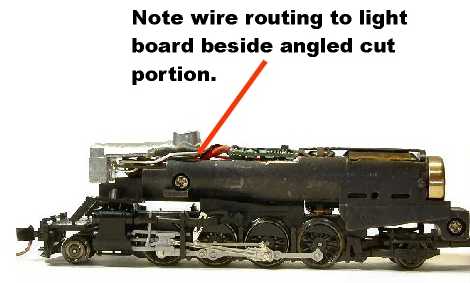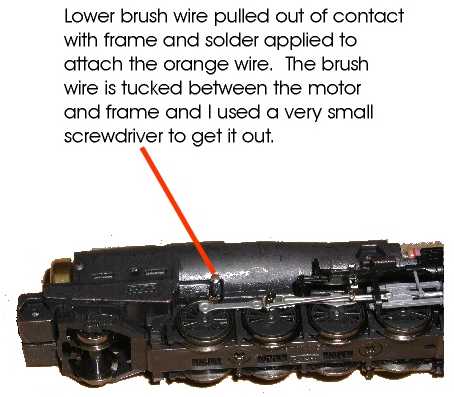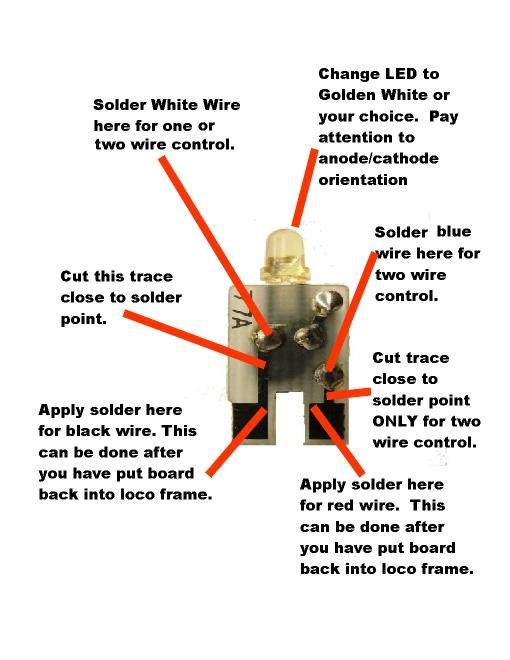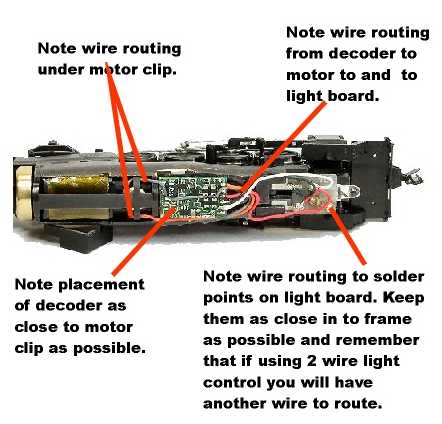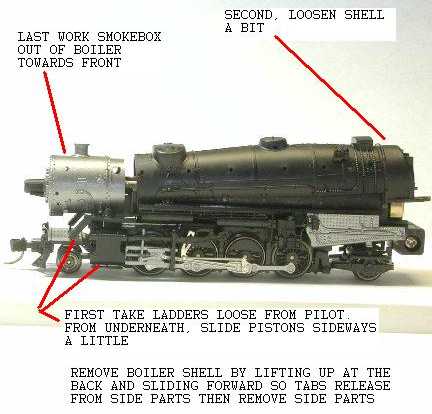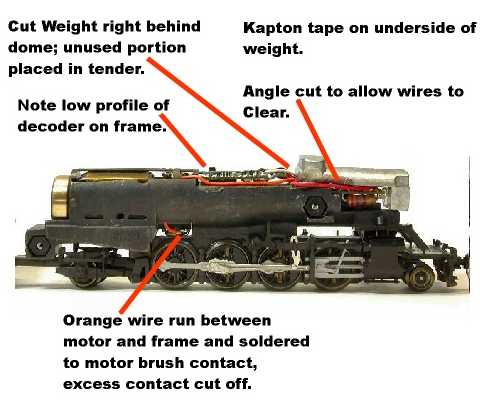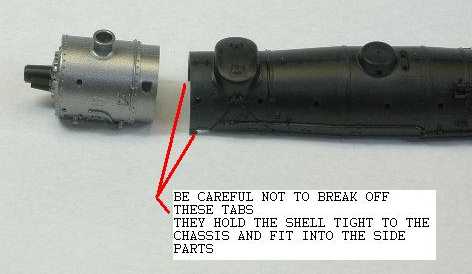Kato Mikado
N scale
In Boiler Installation
by Mike Mogensen, n_meister@mw.net and
Dave Petty
The only other decoder installation I had seen is for
mounting a decoder in the tender for this loco.
I did this with my 1st one and it worked OK but I didn’t like
the wires running between the tender and the loco.
I studied the next Mikado I got and came up with this procedure to
place the decoder in the boiler and it has worked very well.
Many thanks and kudos to Dave Petty and Allan for their time, untiring
assistance and patience in preparing this text and pictures.
PREFACE:
This install is NOT for the faint of heart; previous experience in
hard wiring decoders is a must as well as experience in dismantling
locos.
I would not recommend this as your 1st hard wire decoder install!
I strongly advise that you read thru this 1st before actually starting.
I’ve installed Digitrax DZ 123’s and 143’s, TCS M1’s
and Lenz 0511W and 0521W’s in these Mikados. All work and fit
very well, just depends on the decoder features you want.
NOTE: I substituted Digitrax wire on the Lenz decoders because they
are thinner and more flexible; the Lenz wires have very heavy insulation
making them hard to form in the small space available.
Speaking of space, it is at a premium in this install. Refer to the
text and pictures for decoder placement.
Use a tester to check your decoder for proper operation before starting
this install.
Use your meter to check that no wires are in contact with the frame
where they shouldn’t be.
ALSO: For soldering, I used an Isotip cordless hand held with Micro
tip.
1. Remove the tender, cab, boiler shell, sideboards, smokebox and weight
so that you just have the frame and running mechanism in hand. Do
the MTL coupler conversion on tender and pilot if desired; this can
be done 1st or last, your choice. Turn the loco over and remove the
tender by pulling it straight back taking care to support the drawbar
and clear the little pin that is engaged in the trailing truck. Remove
the cab and the part beneath it. Pull the ladders loose from the
pilot; they fit in there with a little pin and then move the pistons
sideways from underneath just enough so that the smokebox can be
pulled out toward the front. It probably will be a little snug so
just work it gently out from under the boiler shell. Loosening the
boiler shell by pulling it up a bit from the back may help here.
If you have a new loco, taking this apart is easier than one that
has the handrails installed. You’ll have to remove at least
the front rails to free the boiler and smokebox from the frame. Remove
the boiler shell by lifting up at the back and moving it forward.
Take care not to break off the little tabs at the front of the boiler
shell. Remove the side parts and weight. Now you’re ready to
get into the fun stuff!
2. LIGHTBOARD: The white wire connection is the easiest to do and
works fine.
3. Cut the trace on the fireman’s side of the board. Change the
LED if you prefer, and solder the white wire to the fireman’s
side LED point. The engineer’s side will pick up power direct
from the frame. NOTE: Once you have decided whether to use both wires
or just one wire and changed the LED, if desired, you can put the lightboard
back in the frame and hook up the wire/wires after the decoder is in
place. Keep in mind that fewer wires always fit better.
4. If you decide to use both wires, also cut the
trace on the engineer’s
side and solder the blue wire to the solder point on this side, the
white wire to the fireman’s solder point.
5. After the lightboard is back in place in the frame, there is one
more step to do: Place a small amount of solder on both the board contacts
right next to the frame. These solder points will be used for the red
and black wires to power the decoder later. NOTE: If you control the
light using only the white wire as in the picture, then you only need
to put solder on the fireman’s side of the board, soldering the
red wire to the light solder point for power. See picture.
6. THE WEIGHT: Cut the weight just even with the rear of the dome and
place the rear piece in the tender. Use 2 sided sticky tape to hold
it in place. (The tender could use some weight anyway whether you cut
the weight and use the front part or not). The remaining piece (front
portion) can be used, with modification, to put back in the loco or
not depending on your specific needs. This loco needs the traction
tire, as you may know. The weight, in one piece, is .375 oz. The front
portion, if put back into the boiler is .250 oz. I’ve put the
weight back in and also have left it out on other Mikes and I don’t
see any appreciable loss of pulling, but then, my layout is an operation
layout with no grades and the number of cars pulled for me is fine.
My friend’s Mike with this install and the modified weight in
place pulls a 2% grade with cars just fine. You will need to shave
off a bit of the weight at an angle beside the dome just so the wires
for pickup and light can clear better to get the boiler shell on. If
using the weight, line the underside with Kapton tape just to insure
that no solder from the light board comes in contact with it or the
weight with the frame especially at the front by the light.
7. MOTOR PREP: You do not need to remove the motor. Remove the top
plastic retaining piece holding the motor and remove the top brush
holder. Remove the copper frame contact strip and apply a small amount
of solder to the side of the brush cap; the gray wire will be attached
here. Using a fine tip screwdriver, get the bottom brush contact strip
out from contact with the frame but leave it connected to the brush
cap and away from the frame. Very carefully, (watch the heat), apply
a small amount of solder to the strip which is now exposed; the orange
wire will be soldered here. I cradled the loco and used my trusty micro
tip for this procedure.
8. DECODER PREP: I removed the shrink-wrap from the decoder very carefully.
Here’s where the Micro tip soldering iron comes in real handy.
I unsoldered the yellow wire, which wasn’t needed, and if you
are using only the white wire for control of the light, the blue wire
can be removed as well. With the wrap removed, it also facilitates
routing of the wires better and takes up less vertical space. I applied
Kapton tape to the bottom side of the decoder.
9. DECODER LOCATION: The decoder sits right in front of the motor area
about one wire width forward of where the plastic motor clip mounts.
Any farther forward and the boiler shell may not fit properly (The
frame tapers toward front at this point). I used 2 sided sticky tape
across the opening where the motor coupler drive is (THIS IS PREVIOUSLY
COVERED BY THE WEIGHT, NOW REMOVED) and affixed it to the frame then
positioned the decoder, with the wires toward the front. Next I routed
the motor wires, gray on top and orange to bottom.
10. WIRING/ROUTING: To route the orange wire, figure the routing, cut
to length and strip and then loosen both frame screws, the back one
(by the flywheel) as far as it can go without coming out and route
the wire between the motor and the frame down toward the previously
soldered motor brush contact. You may have to hold the frame apart
a bit to get the wire between it and the motor but it will go OK (this
is why I use the Digitrax wire). Again the Micro tip comes in handy
to solder the wire as close to the brush cap as possible on the contact
strip being careful to use as little heat as possible. I put the loco
in a foam cradle for stability to do this. Once this is done (see picture),
snip off the excess contact strip as short as possible. You may need
to put a piece of Kapton tape on the frame just at the lower edge above
the motor opening if the contact would touch the frame but it shouldn’t
be necessary if you soldered the wire close to brush cap and snipped
the excess off close. Retighten both frame screws. Solder the gray
wire (routed, measured, stripped and tinned) to the side of the brush
cap and reinstall the cap, spring and brush into the motor. Route wires
around and under the top motor clip and install. NOTE: If the wires
are a little long, you have a little room just behind the weight and
forward of the decoder to take up the slack. If you don’t use
the weight, then there is more room.
11. Route the red and black wires and attach to the previously soldered
points on the light board, red to engineer’s side, black to fireman’s.
Route the white and blue wires (if using both, then only the white)
and solder in place on the light board.
12. Attach the tender and do the usual checks of the decoder. All should
be working and running OK. Install the weight (modified if you are
going to use it) keeping the wires as close in as possible and put
the boiler pieces back on in the reverse sequence. Enjoy!
